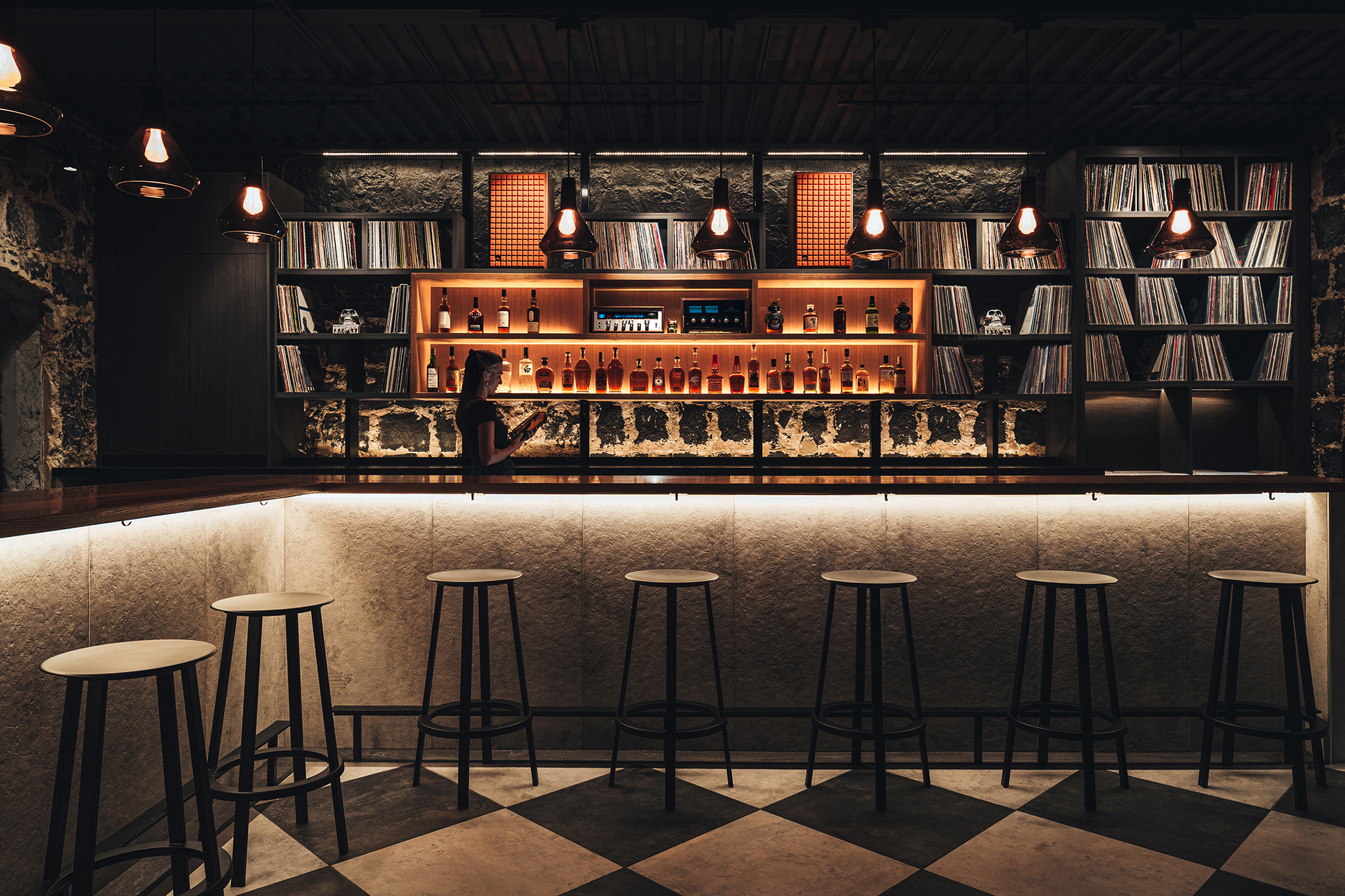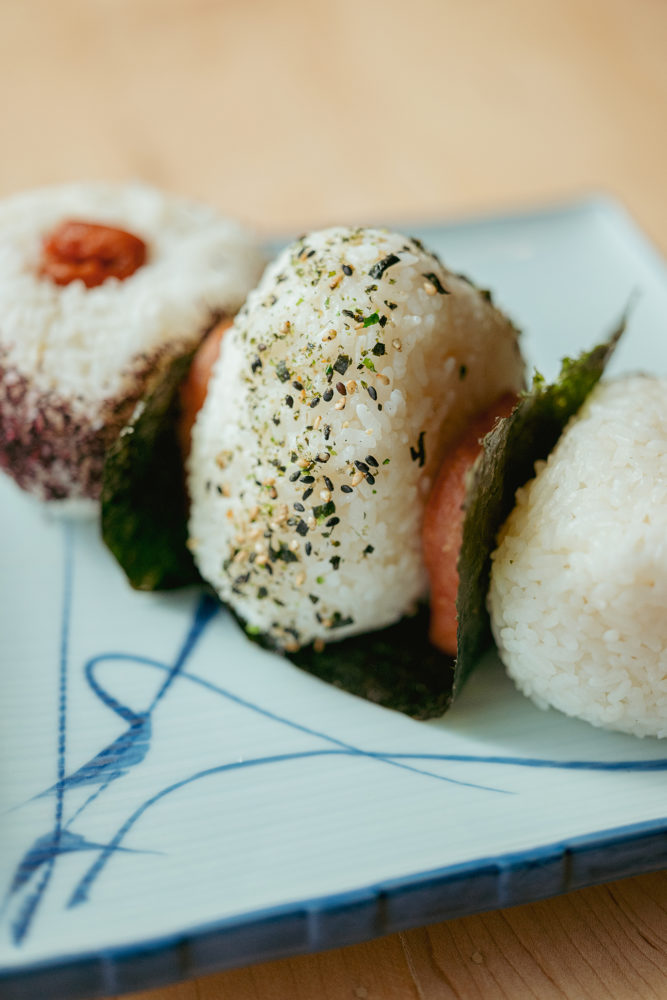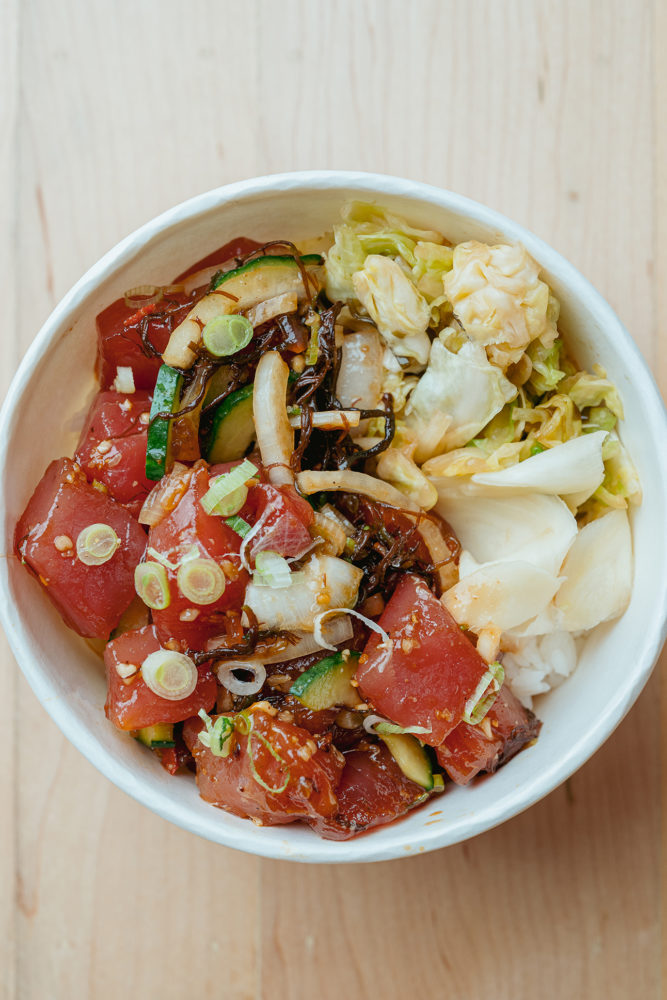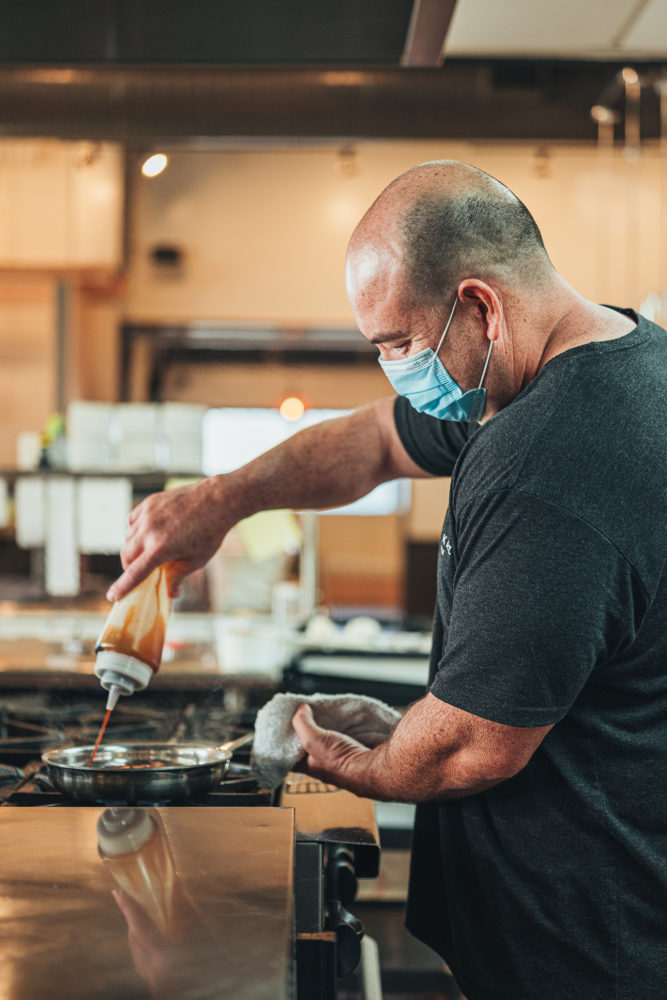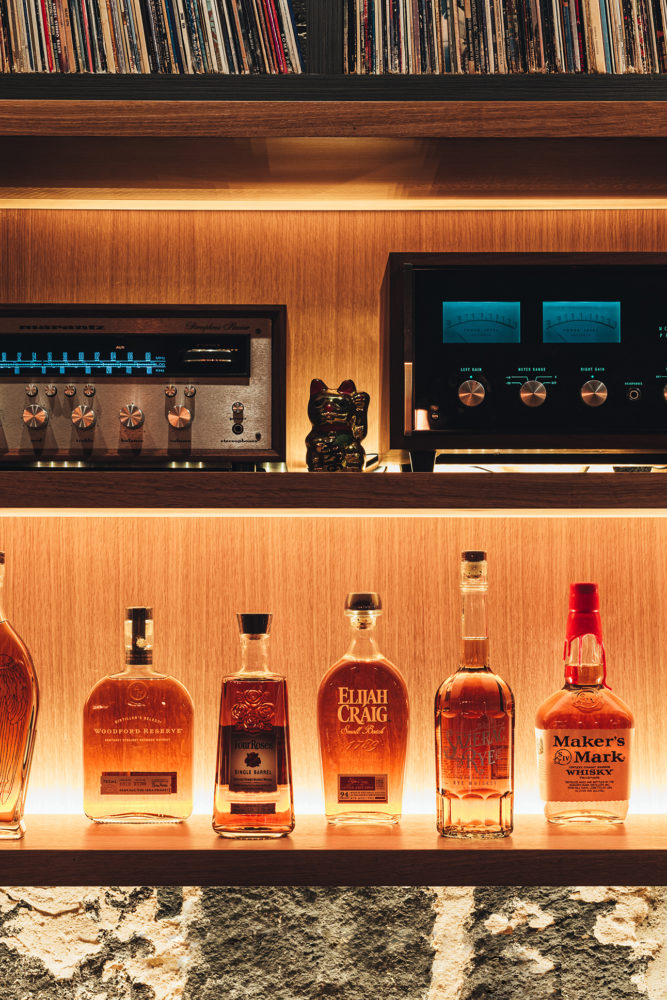These two Honolulu restaurants pay homage to beloved food and drink experiences with vintage hallmarks at their hearts.
I am a San Diego kid, growing up in the 1980s. There is a black crocheted afghan with neon flowers hanging over the back of our living room couch. I’m sitting on the floor flipping through my mom’s record collection listening to The Bee Gees and The Rolling Stones, stealing my favorite album covers to tack up on my bedroom wall later. In my brother’s room is an Atari and a tweed swivel chair that I spin in it for hours while playing Frogger. Four decades later, I still feel warmly about the aesthetics of that time.
That’s because oldies are goodies. It is why we cherish wearing vintage aloha shirts or sitting at the counter at Liliha Bakery on Kuakini Street. Entrepreneurs in Honolulu such as chef Jason Peel and DJs Ryan Miyashiro, Chris Nakano and Daniel Ng understand the power of nostalgia and are proving brilliant at capturing the marrow of the past when opening something new.
In Honolulu, okazuya delis have been fueling local workers through long days of labor since the turn of the 20th century. By the year 1900, way before plate lunch wagons ever hit Honolulu Harbor, there were already 100 okazuya in Hawai‘i.
Some believe because of their resemblance to ekiben, the takeout eateries found in train stations that serve bountiful bentos for extended train rides in Japan, that the concept arrived to the islands with the first Japanese contract laborers who came to work the sugar plantations.
As these immigrants left the fields to open their own businesses in the 1920s, many opened what became known as okazuya, local delis that serve pre-made, affordable dishes presented cafeteria-style, like the since-shuttered Sagara Store in Waialua or the Mōʻiliʻili staple Fukuya, which still has lines out the door at 6:30 a.m. after more than 80 years in business. The concept is unique to Hawai‘i and arouses an enduring nostalgia that was practically begging to be reimagined by a new generation.
Jason Peel, a celebrated chef and driving force behind restaurant openings such as Miro, Papa Kurt’s and Hau Tree Lanai, decided to serve okazuya classics at his new restaurant Nami Kaze, while preparing to launch a full-service izakaya. As a mixed-Japanese Kaua‘i boy, Peel’s childhood is revealed in every bite.
“Okazuya is very nostalgic to me,” Peel said. “I’m a white paper box lunch kind of guy.”
As a teen, Peel’s favorite okazuya was across the street from Kauaʻi High School. In his memory the establishment’s name is hazy, but the contents of its white takeout box are as clear as the okazuya’s glass noodles: a thick slice of teri beef, two fried chicken wings, mac salad, salted cabbage, a piece of luncheon meat, and a musubi that stuck to the paper when you tried to pick it up.
“Growing up, it was the best,” Peel said.
At Nami Kaze, the fried shrimp and ginger chicken are inspired by Hanamaulu Cafe, the 1920s okazuya that closed its doors in 2014. The potato salad made with spaghetti noodles is a version of his 102-year-old grandmother’s recipe and the musubi with fried Göteborg sausage was inspired by family trips to the beach when he was a kid. When he told me the story, I imagined Peel and his siblings running down to the shore to rinse their hands in the ocean before lunch.
“You’d salt your hands and make your musubis,” Peel remembered. “My auntie would fry some salt and pepper chicken, she’d fry up some Göteborg, and it would sit out all day at the beach and we’d eat it all day.”
Peel’s okazuya 2.0 experience also modifies the expectations of the classic business. He does away with the extensive lines that one is notorious for, offering online ordering instead. He also rarely, if ever, runs out of food, and he sources ingredients locally, emphasizing the use of fresh vegetables and seasoning. Laughing, he tells me they use so many Thai chiles that on some days you can “almost die” from the amount of pepper particles swirling in his kitchen.
For Peel, it’s a delight to walk into an okazuya and find offerings that “make you remember your childhood,” he says, “but also that’s seasoned!” Intending to push flavor profiles and put a slight twist on dishes, Peel really wants the food to pop.
The most notable update to his neoteric approach, however, is that he makes the food fresh every day in small batches throughout service to maintain quality, saving perfectly cooked food from their slow demise sitting under a heat lamp or in a steam table.
“I get so sad when I go,” he reflected on today’s existing okazuya delis, considering sweet and sour spareribs, as an example. “I’m sure when they first make it it’s really good, but I mean the thing’s just sitting there and sitting there … next thing you know you have dry pork.”
Like its predecessors, Nami Kaze serves local Hawai‘i food born out of the plantation era, when workers from an array of ethnic groups began commingling together over meals. More than a century later, Peel’s white paper boxes shine with fresh vegetable namasu, sparkling poke, and kakiage that is actually crunchy.

In postwar 1950s Tokyo, owning records were a luxury. Listening bars, then, offered music lovers a place to relax and listen to jazz or classical music on a proper sound system. Business owners could share their passion with patrons over a cup of coffee or tea at a kissaten, a modest coffeehouse. Over time, venues began staying open later, offering libations, and playing edgier music genres. In Honolulu’s Chinatown, Ryan Miyashiro, Chris Nakano and Daniel Ng introduced their version of this concept in January 2022 with EP Bar, Hawai‘i’s first listening bar.
Miyashiro was captivated the first time he walked into JBS Bar in Tokyo’s Shibuya district. The tiny bar was packed with records floor to ceiling and a crowd of fashion creatives centered around the bar’s owner, a white-haired man with glasses named Kobayashi Kazuhiro, who was serving drinks and playing ’90s hip hop on two turntables simultaneously.
“No requests, even with drinks,” Miyashiro recalled. “He will literally just offer you highballs or beer.”
Miyashiro was most impressed by the record that was playing: “Carmel City” by hip-hop duo Pete Rock and C.L. Smooth.
“To see something like that, I was like, ‘Holy shit!’” Miyashiro said. “And in another country? This wasn’t even New York, this was Japan. I’m like, ‘This is literally the coolest fucking thing I’ve ever seen in my life.’”
At EP Bar, the DJs, or “sound selectors,” as Miyashiro calls them, curate playlists on MasterSounds turntables and mixers. To give an old school look, the owners purchased burnt orange JBL speakers that look vintage, but are built with modern technology and second-hand refurbished 1970s Macintosh amplifier and receiver. The building’s historic brick walls and archways surround two glowing amber shelves of spirits and conjure a medieval feel, perfect for the intimate, den-like atmosphere that EP Bar is going for. Miyashiro gives credit to Tokyo’s vinyl listening bars for inspiring the vibe of EP Bar’s space.
The playlists are eclectic, curated, and a Chinatown community affair. Familiar faces from around the neighborhood like Travis Sesaki, the co-owner of Bās Bookstore, and Kamalu Fung, an employee at Sig on Smith, make weekly appearances as DJs, spinning everything from jazz to Hawaiian.
The craft cocktail menu includes highballs created by Justin Park of Bar Leather Apron and Bar Maze, and a signature old fashioned made with black sesame infused bourbon by bar director Samantha Trusty. EP Bar tries to stock spirits not every Honolulu bar has such as Four Roses Bourbon and Makers Mark 101. The bar even offers pét-nat, or pétillant naturel, a genre of natural sparkling wine that has yet to find footing in Hawai‘i’s bar scene.
“I grew up in a sneaker streetwear culture, so I like limited edition things,” Miyashiro explained.
In Japan, many listening bars don’t allow talking or snapping photos, according to Miyashiro. While the intent at EP Bar is for people to sit and listen to the music, its owners know that’s likely not enforceable.
“It’s still America, people do what they want here,” Miyashiro laughs, explaining that no one at EP will scold patrons for chatting with their friends or taking selfies. “We won’t stop you from doing those things, but we’re trying to give you something that’s us. It’s like you’re walking into our home.”
I laugh with Miyashiro, too, but also lament America’s individualist-centric attitudes — the “I’m going to do what I want” credo that can unfortunately prevent Americans from exploring and embracing different ways of being, even in Hawaiʻi. His sentiments around home resonates, though, and it dawns on me that the reason vintage anything is inherently important is because it paints our past and rekindles joyful parts of us.
Oldies are goodies. It is why we cherish wearing vintage aloha shirts or sitting at the counter at Liliha Bakery on Kuakini Street.
Sarah Burchard
It isn’t only that Peel is wistful for the okazuya of his childhood. At Nami Kaze, he has a chance to embody his role as a son, a grandson, and a boy at the beach with his family all at once. At EP Bar, Miyashiro’s recreation of a place and time he loved on a life-changing vacation, did something similar when it transported me back to the hippie-kid-punk-rock-raver-teenage-daughter-of-a-musician I used to be as I sat in one of his barstools.
Both joints use modern twists to entice new generations to their spaces, but it’s Nami Kaze and EP Bar’s nostalgic roots that keep you coming back. It’s not just an okazuya, not only a listening bar, but temporal dimensional portals that remind us we’re not simply this present moment—we are every memorable meal, song, and moment, carefully collected from the past.

